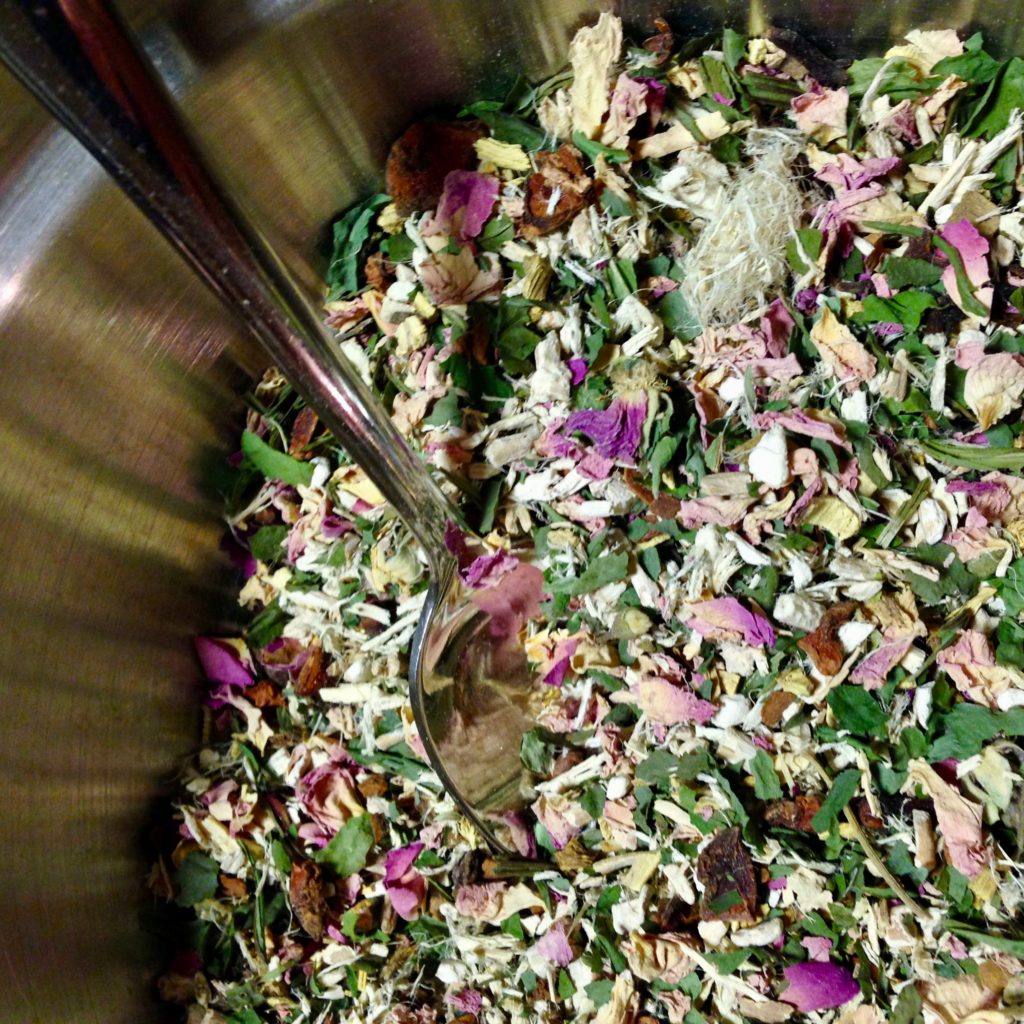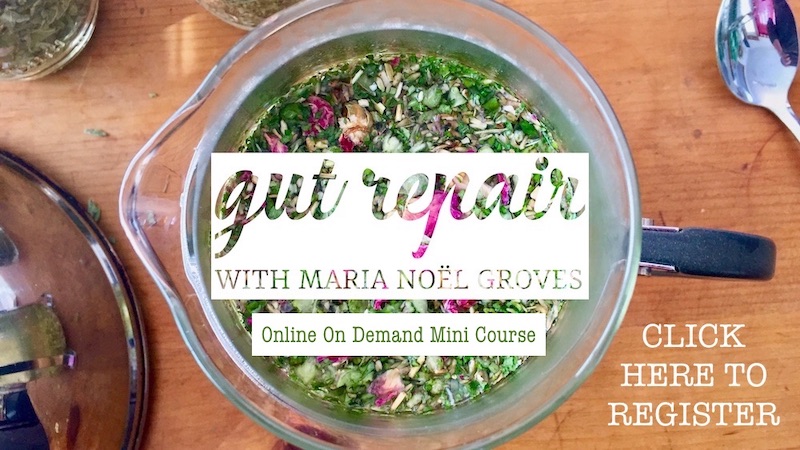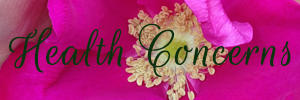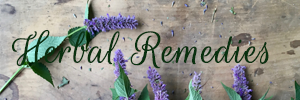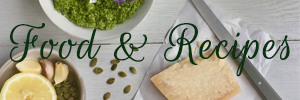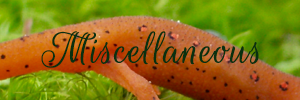Digestive distress is increasingly common in the United States, where acid-reducing drugs are the third most prescribed pharmaceuticals. Our diet, stress, hyper-hygienic lifestyle, and medication use (antibiotics, pain relievers, birth control, and more) all do a number on gut health and motility. One area of increasing concern is the integrity of gastrointestinal lining from top to bottom. Fortunately, herbs do a lovely job easing irritation, promoting tissue integrity and repair, and encouraging healthier digestive function.
Soothing and healing herbs can be helpful in a range of types of digestive distress – acid reflux, ulcers, leaky gut (also called intestinal permeability), small intestinal bacterial overgrowth (SIBO), irritable bowel syndrome (IBS), inflammatory bowel disease (IBD), post-GI infection, and more. Sometimes modern medicine is also necessary. Most herbalist combine gut-healing teas with a broader customized holistic approach that addresses individual needs, diet changes, supportive nutrients and supplements, etc. However, a gut-healing tea can be an amazing ally in the healing process.
Why Tea?
Making a strong herbal tea allows us to get a lot of herb into direct contact on the gastrointestinal lining in a soothing and easily absorbed format. Alcohol-based tinctures might be fine for potent bitter and antimicrobial herbs, but alcohol is by nature irritating and water does a better job extracting the constituents we want for to soothe and heal the gut. Slimy soothing mucilage, a mainstay for many gut-healing teas, prefers water over any other solvent to release and activate its benefits.
Customize Your Own Gut Healing Tea
Gut healing teas are incredibly customizable based on your specific needs and flavor preferences. Think about your personal patterns. Is your digestion overly rapid and irritated or slow and sluggish? Do you tend towards diarrhea or constipation? Do complex starches feel soothing or worsen gas, bloating, or reflux? Do spices feel delightful or irritating? What flavors do you enjoy or detest? This will help guide your herb choice.
Start with small batches and consider single ingredients at first to get a feel for which herbs agree with you. No one herb agrees with everyone, your body will usually tell you pretty quickly if it loves or hates mucilage, bitters, spices, etc. Listen to what makes you feel better and what makes you feel worse – follow your gut.
If you’re pregnant, nursing, on medications, or have high blood pressure – these situations may warrant avoiding certain herbs, such as licorice. Complex or serious diseases may exceed the bounds for self-treatment. Consider enlisting the aid of an herbalist or holistic practitioner to guide you, as well as a gastrointestinal diagnostic work up if you don’t know what’s wrong with you, particularly if you’re experiencing persistent changes in your stool, bloody stool, unusual pain, signs of infection, fever, unexplained weight loss, etc.
Key Ingredients Categories
There are many plants to consider for your tea blend. The core ingredients fall into three main categories:
1. Demulcents soothe, coat, and support a healthy mucus lining. Mucilaginous herbs are demulcents that are particularly viscous and mucus-like.
2. Vulneraries encourage wound healing and connective tissue integrity. These are herbs we also use on our skin to promote vitality and heal cuts and scrapes. They have similar benefits internally.
3. Carminatives are flavorful herbs that synergize and flavor the blend while supporting healthy digestive function.
Even within these categories, different herbs will have different affinities. You can pick the herbs you have on hand, that you like the taste of, or those that provide the most targeted benefits for your needs. Let’s deep dive into these core herbs…
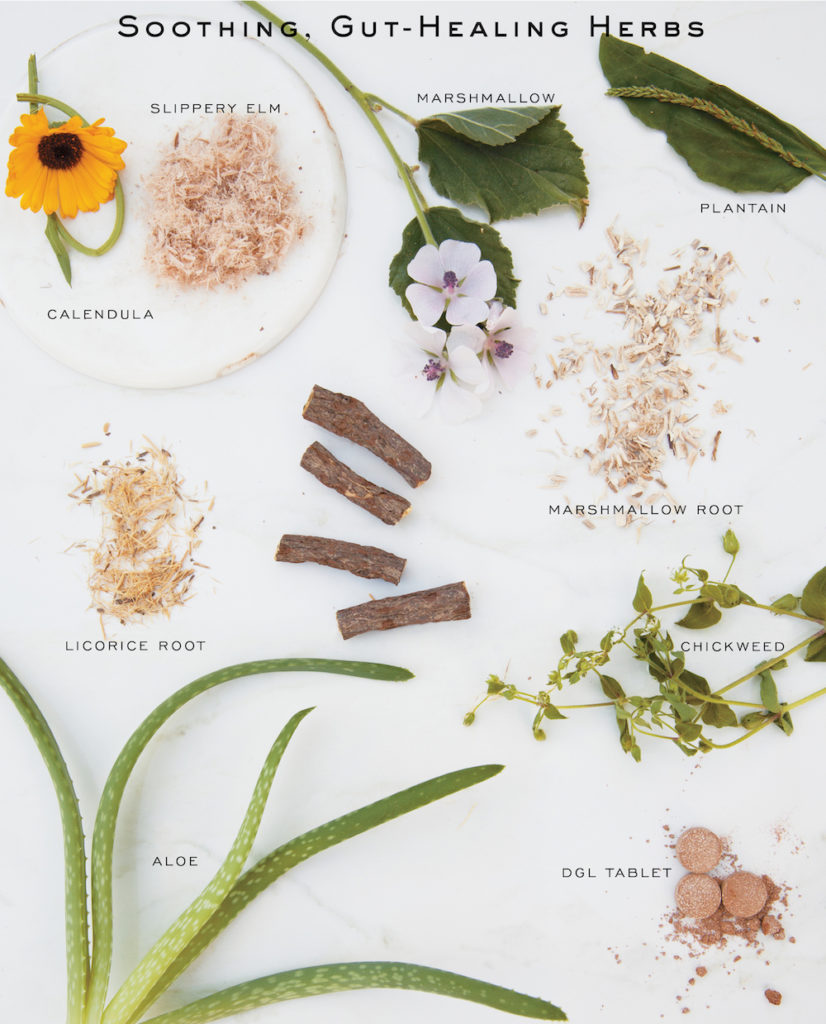
Demulcents
Demulcents often form the base of your gut healing tea. If your GI tissues are irritated, dry, inflamed, or damaged, these herbs slime and soothe while promoting healing. Mucilage forms a temporary mucus-like barrier on the gut lining to allow for repair and also feeds gut flora. Mucilaginous demulcents like marshmallow root and slippery elm bark – especially powdered – get mucus-like. Milder mucilaginous herbs like marshmallow leaf simply offers a velvety mouthfeel. Meanwhile, plantain leaf and licorice root are demulcent without being very slimy (mucilaginous) at all.
Mucilage doesn’t agree with everyone. If you have SIBO and find that eating starchy, high-FODMAP foods give you gas, bloat, or reflux, then you may want to opt for less mucilaginous demulcents. First, slowly introduce to give your gut flora a chance to adapt. If even low does don’t agree, then stick with more SIBO-friendly herbs like plantain leaf. Most low-FODMAP folks tolerate marshmallow leaf and licorice but may react strongly to marshmallow root powder and slippery elm. You can often use a low- or non-mucilaginous demulcent even if you don’t tolerate mucilage.
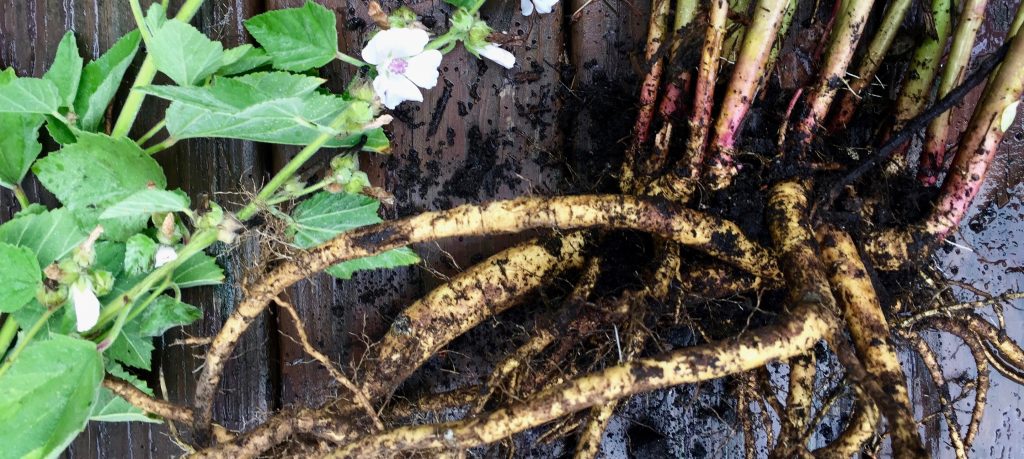
Marshmallow (Althaea officinalis) plays a star role in almost all the gut healing teas I formulate for my clients, generally 30-60 percent of the blend. I use root, leaf, or both. The cut and sifted root makes a moderately mucilaginous tea whereas the leaf is a little milder but still pleasant and soothing. The flavor is also pleasant and mild. Let them steep for several hours to extract more optimal amounts of mucilage. Some prefer to start with cold water, but I don’t find it matters, and hot water will extract properties better from other herbs in the tea blend. The root also provides some deep immune tonic benefits. The root powder is incredibly soothing and highly mucilaginous but also more likely to bother someone that is sensitive to FODMAPs, causing gas, bloat, and/or reflux. Taking a lot of mucilage (especially as powder) alongside medications or supplements may slow or reduce their absorption – try separating them by a few hours. Slippery Elm bark offers similar properties as marshmallow root but is a tad more mucilaginous. I don’t generally use it because marshmallow is much more sustainable.
Licorice (Glycyrrhiza glabra) root is demulcent, soothing, anti-inflammatory, vulnerary, and moderately antimicrobial – a fine combination of actions for healing the gut. It’s not particularly slimy or mucilaginous yet supports the gut lining’s own mucin production. It’s sweet and flavorful. Perfect, right? Unfortunately, it doesn’t agree with everyone. Some people find the flavor repulsive, and long-term or high doses may cause serious health issues. Licorice may disrupt various hormones (reproductive, blood pressure, stress hormones), raise blood pressure, cause life-threatening potassium depletion, and interact with some medications. In people with a low risk for side effects and interactions, five percent of crude licorice in your blend might be fine, although I often skip it.
DGL (deglycerized or deglycyrrhizinated licorice) provides a safer licorice alternative. The glycyrrhizin has been removed, which dumbs down licorice’s healing properties yet improves safety. Glycyrrhizin does contribute healing benefits, but it is also the source of most toxicity and interaction concerns. DGL is commonly available as chewable tablets, pure powder, or in pill formulas; follow label directions. I don’t typically use DGL as tea, but you could stir some in.
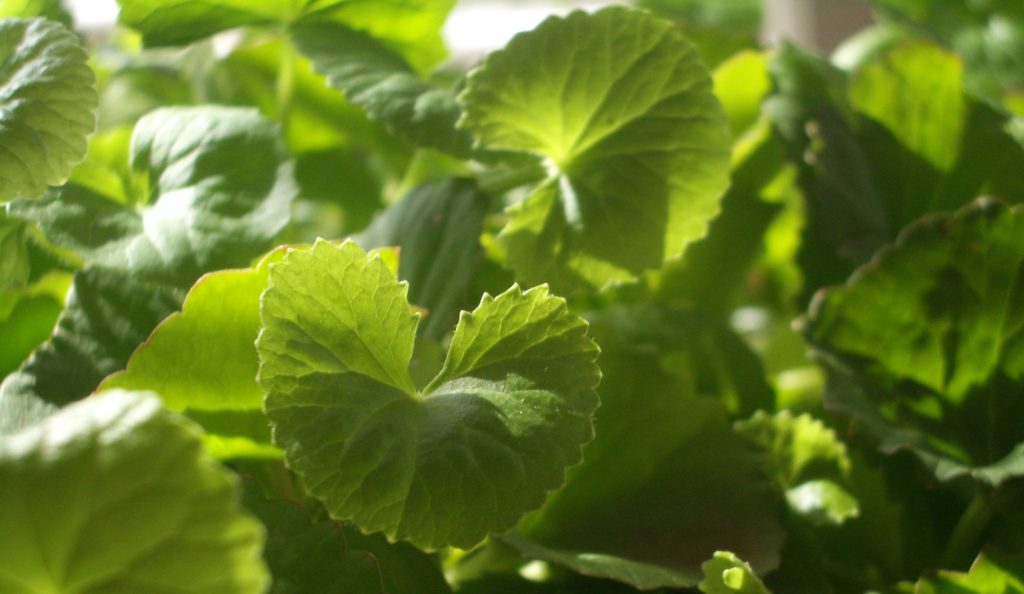
Vulneraries
Alongside the demulcents, vulneraries help speed up the healing process and improve the integrity of the gut lining as it heals. Favorites include gotu kola, calendula, and plantain leaf. Although comfrey is technically a gut vulnerary with amazingly fast healing actions, it’s also potentially liver toxic, so I don’t recommend it. I also find that gotu kola, calendula, and plantain may not be as fast-acting as comfrey, the quality of repair is better, leading to superior connective tissue integrity in the long run. And, of course, gotu kola, plantain, and calendula are much safer.
Plantain (Plantago spp.) makes an appearance in almost every gut tea I blend, generally about 15 percent though you could certainly go for more. It’s a fabulous demulcent and vulnerary that’s also slightly astringent and antimicrobial yet not particularly mucilaginous. It’s profoundly soothing, healing, and agrees with almost everyone. The flavor is mild, pleasant, tannic, perhaps a little sweet. Plantain is a common weed – most famously used as a skin poultice for bug bites, poison ivy, and bee stings – yet it’s not as easy to find in commerce as a bulk tea. I prefer getting it direct from local herb farms, and you may be able to grow and dry your own if you have an abundance in your yard. It’s tedious to harvest, so don’t be surprised if it’s a little more expensive than other herbs even though it’s a common weed. Make sure your source is trustworthy and that you know your plant identification; lance-leafed English plantain can be confused with other plants, including deadly toxic narrow-leafed foxglove.
Calendula (Calendula officinalis) is the darling gut tea ingredient for many of my colleagues, including Thomas Easley and Juliet Blankespoor, who often combine it with plantain, marshmallow, and/or meadowsweet. Calendula is a fantastic vulnerary, anti-inflammatory, and mild antimicrobial. But I have a hard time using more than a sprinkle of the flowers in tea blends because it’s also bitter and vitamin-y tasting. Even though that bitterness is helpful to stimulate digestive juices, I just don’t like the flavor in therapeutic doses. If you’re allergic to daisy family flowers, be cautious introducing calendula, which is related.
Gotu Kola (Centella asiatica) is often ignored due to its exotic origins versus the other Euro-centric herbs. This brain tonic from Ayurveda is well known and loved throughout India and Southeast Asia for a myriad of uses including its ability to repair and improve the integrity of connective tissue, blood vessels, and nerves. David Winston recommends it when the tissue is “red, hot, and inflamed.” It’s also a mild stress-relieving adaptogenic and calming herb, though these effects are subtle, building over time. Gotu kola’s flavor is ok, somewhat bland, sometimes a bit seaweed-y, tannic, celery/parsley-ish, but flavorful herbs in your blend should mask it.
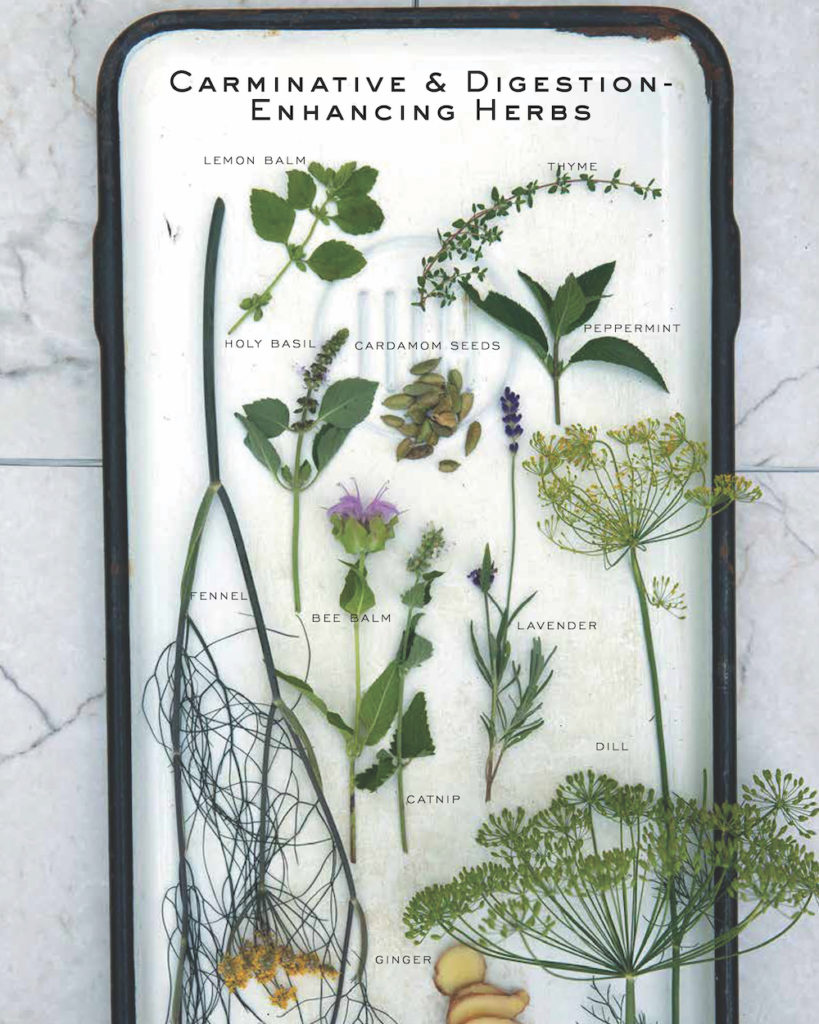
Carminatives
What’s a carminative, you ask? Open up your spice and tea cabinets, and most of what you’ll find is carminative. These essential oil-rich aromatic herbs relax muscle tension and spasm and stimulate digestive function. They’re often warming, flavorful, and delicious. Each has its own unique additional healing features. Choose by flavor and/or action. These can make up five to sixty percent of your blend. Chai spices are my favorite, but you could go in a different direction and turn to mint, holy basil, etc.
Maria’s Favorite Chai Base is delicious on its own but can also be used to flavor other gut healing herbs. Combine 2 cinnamon sticks (or 1-2 teaspoons of cinnamon chips), 2 cardamom pods, 5-7 cloves, 1 star anise pod per 12-16 ounces of tea. It’s best simmered for 20 minutes but can also be steeped.
Cinnamon (Cinnamomum spp.) is sweet, delicious, antimicrobial, slightly mucilaginous, and relatively astringent – helpful for tightening gut lining, dealing with pathogens including dysbiosis, and staunching chronic diarrhea. It’s so delicious, it could represent ten to 60 percent of your blend. Cinnamon’s blood sugar lowering effects could be helpful or contraindicated depending on the person, medications, whether or not the tea is sweetened, and if you’re drinking it with food or on an empty stomach. The astringency can be constipating; adjust the dose or remove as needed. Some theoretical concerns have been raised regarding blood-thinning, liver-toxic coumarins in cassia cinnamon. I’m not particularly concerned – I’ve yet to see any human case reports or clinical trials showing a problem, and cinnamon has a long history of use in large quantities. But if you want to err on the side of caution, Ceylon cinnamon has fewer coumarins.
Ginger (Zingiber officinale) fresh or dried root adds a potent warming and anti-inflammatory action for blends, which stimulates digestive juices and function, lighting the digestive fire. This is perfect for sluggish digestion but will worsen hot, irritated, inflamed, or damaged GI lining. It can make reflux better or worse depending on the person and is not recommended in acute ulcers. Most people already know whether or not they are “ginger people” – you’ll feel noticeably better or worse after one cup. Fresh grated or sliced ginger is quite warm but not as hot as dry and also has more direct antimicrobial effects against gut pathogens while promoting beneficial gut flora.
Cardamom (Elettaria cardamomum) gives your tea that little something special, reminiscent of Indian masala chai and garam masala curry. Cardamom is a potent flavoring and digestive stimulant that’s also antimicrobial. Just one or two cardamom pods per mug is plenty, but feel free to increase to your personal preference. Leave pods whole, crush to open, or grind to a powder. For large batches of tea blends, I crush gently to release the seeds or grind. I add cardamom for people who love the flavor and need a little extra kick for digestive function, but I skip it for sensitive stomachs that are easily irritated by bitters and spices.
Cloves (Syzygium aromaticum) is a flavor people love or hate, but it melds nicely with fellow pie/chai spices. Clove is a potent antimicrobial that also numbs and eases pain and inflammation. It’s easy to overdo and can get too astringent and overpowering, just five percent whole cloves (or five to seven per cup) is plenty, less if you grind them.
Fennel (Foeniculum vulgare) seeds are gentler, soothing, and sweet. They’re potently antispasmodic, perfect for gas, pain, bloating, and colic – a perfect addition for people with these issues including IBS. Most people enjoy fennel’s sweet, licorice-y flavor, though some batches and varieties will be sweeter than others. Anise seeds (Pimpinella anisum) are similar. Go for five to 20 percent. Some sources list it as a FODMAP, but it’s rarely a problem as tea.
Star Anise (Illicium verum) provides intense sweetness with a more Southeast Asian fennel-y flavor with a hint of root beer that many people enjoy, especially alongside other spices like cinnamon, clove, and cardamom. It’s also somewhat antispasmodic and antimicrobial. Five percent or one to two star anise pods per mug is usually plenty. If making a big batch of dry tea, I crush star anise into small chunks or grind coarsely.
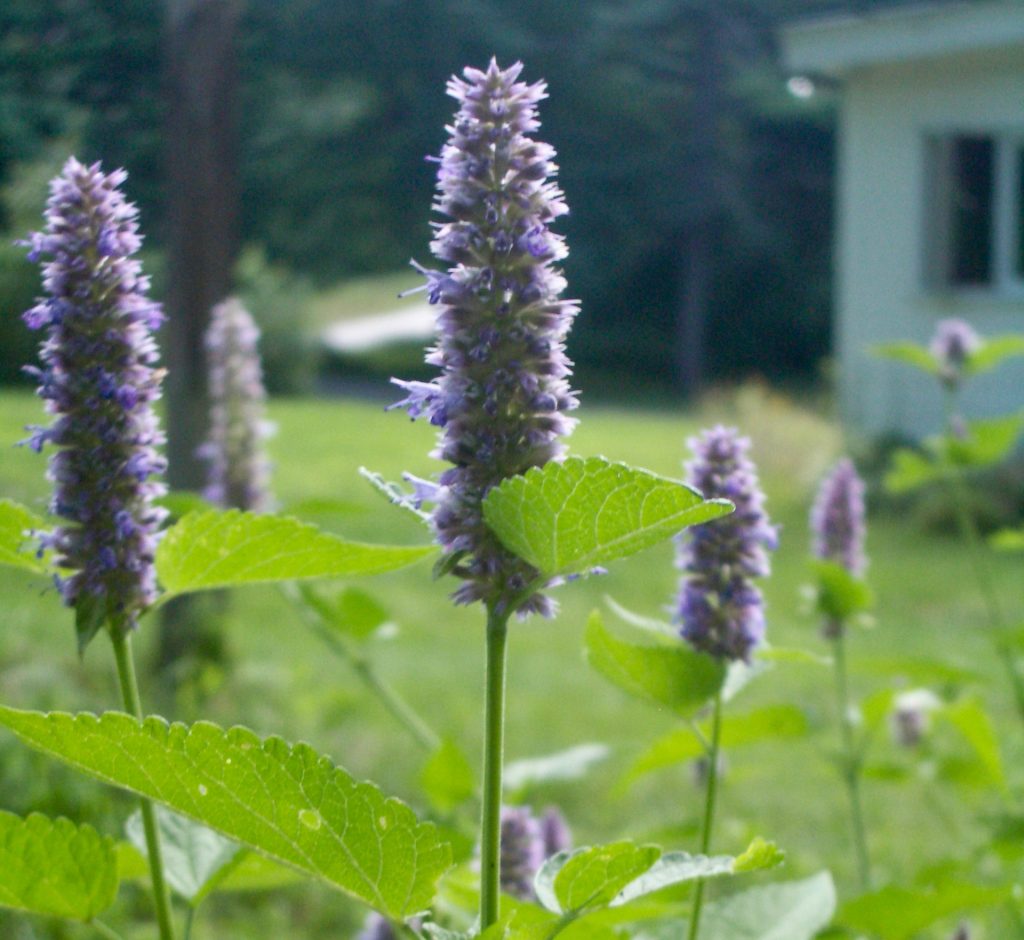
Korean Licorice Mint (Agastache rugosa) and Anise Hyssop (A. foeniculum) are easy-to-grow garden herbs that bridge the flavors and medicinal activities of sweet fennel with a hint of mint. All aerial parts can be used – leaves and flowers. They’re not often available in commerce, but search for it direct from herb farms or grow your own. It’s a prolific, delicious, easy to grow herb for flavoring all sorts of tea blends with local ingredients. Agastache eases gas and bloating, gently stimulates digestive function, and soothes irritation. There’s quite a bit of variation amongst these two species – I prefer plants that have a softer, sweeter fennel-honey versus a sharp minty-fennel flavor.
Chamomile (Matricaria chamomilla) flowers ease gas, bloating, and colic while discouraging pathogens and dysbiosis, stimulating digestive function, relaxing nervous indigestion and anxiety. Popular for fussy babies, it also works for fussy, cranky adults. Short steeps provide a pleasant hay-pineapple-apple flavor while longer steeps will be stronger and more bitter. Mints blend nicely with chamomile to enhance the flavor. Some people are allergic to the daisy-like flowers, which are also tedious to harvest and therefore somewhat expensive. Some sources list it as a FODMAP, but I rarely see problems.
Lemon Balm (Melissa officinalis) has mild calming, uplifting, gentle carminative, vaguely bitter action and a bland flavor that blends nicely tea, especially for folks who are anxious or have nervous indigestion.
Mint (Mentha spp.) leaves are a classic carminative, flavoring agent, and digestive stimulant that also ease gas, pain, and bloating. Peppermint is stronger but may be too irritating for sensitive digestive systems, reflux, and ulcers. Other mints like spearmint and apple mint are milder and may or may not be tolerated. Mint’s best for people with sluggish digestion. You’ll know you’re a “mint person” if you love it and immediately feel better (not worse) when you drink it. Mint blends well in tea with fellow garden herbs chamomile, marshmallow, plantain, calendula, gotu kola, and/or Korean licorice mint.

Worthy Additions
Rose Petals (Rosa spp.) make an appearance in almost of my gut teas for a couple different reasons. Most importantly, they’re pretty, and their beauty and healing vibes make you smile as you brew your cup and foster self-love and self-care (two important things for everyone, especially those dealing with GI upset). Rose aromatics calm and nourish the emotional heart. Astringent tannins help tone gut lining and discourage pathogens while supporting healthy gut flora. Just a sprinkle is fine (about five percent) – roses can get bitter in excess and those precious petals are expensive.
Meadowsweet (Filipendula ulmaria) is unique in that it’s one of the few aspirin-like herbs that is beneficial instead of irritating for the GI lining. Many herbalists include it in their gut blends, including Juliet Blankespoor, Katja Swift, and Ryn Midura. Meadowsweet is a gentle yet complex plant that contains a nice fuzz of anti-inflammatory salicylate and methyl salicylate compounds to reduce pain and inflammation. Most other salicylate-containing herbs (as well as related nonsteroidal anti-inflammatory drugs – NSAIDs – like aspirin and ibuprofen) paradoxically increase inflammation in the gut, irritate the lining, and can cause stomach upset and ulcers. But meadowsweet actually soothes the gut and reduces GI inflammation. Meadowsweet is even included in supportive teas for acute ulcers, to ease the pain. Meadowsweet’s flavor is slightly sweet (hence the name) and pleasant, with hints of cherry, honey, and watermelon. It’s slightly demulcent and mucilaginous (especially the flowers) as well as a little astringent (especially the leaves) – doing a cooler infusion will amplify the soothing properties while heat extracts more astringent tannins. For those who need to buffer those astringent tannins, add some honey and/or marshmallow to the blend helps.
Additional Supportive Herbs
Depending on the situation, you may consider additional herbs for your blend.
- Astringents to tighten and tone the gut lining. In larger amounts, they ease chronic diarrhea. Favorites include rose petals and cinnamon.
- Bitters to stimulate digestive juices and peristalsis when it’s sluggish. For tea, milder burdock or chamomile are nice.
- Antimicrobials when SIBO, non-emergent dysbiosis, or gut pathogens are present (though in some cases antibiotics or medical treatment may be necessary). Nice ones for tea include clove, cardamom, cinnamon, licorice, Korean licorice mint, roses, and/or chamomile. Also consider pau d’arco, though there are sustainability concerns for this tropical tree bark.
- Stress Support options include gotu kola, lemon balm, and/or holy basil to calm and uplift, ashwagandha for deep energy, codonopsis for more zippy energy. Chamomile for stronger calming effects.
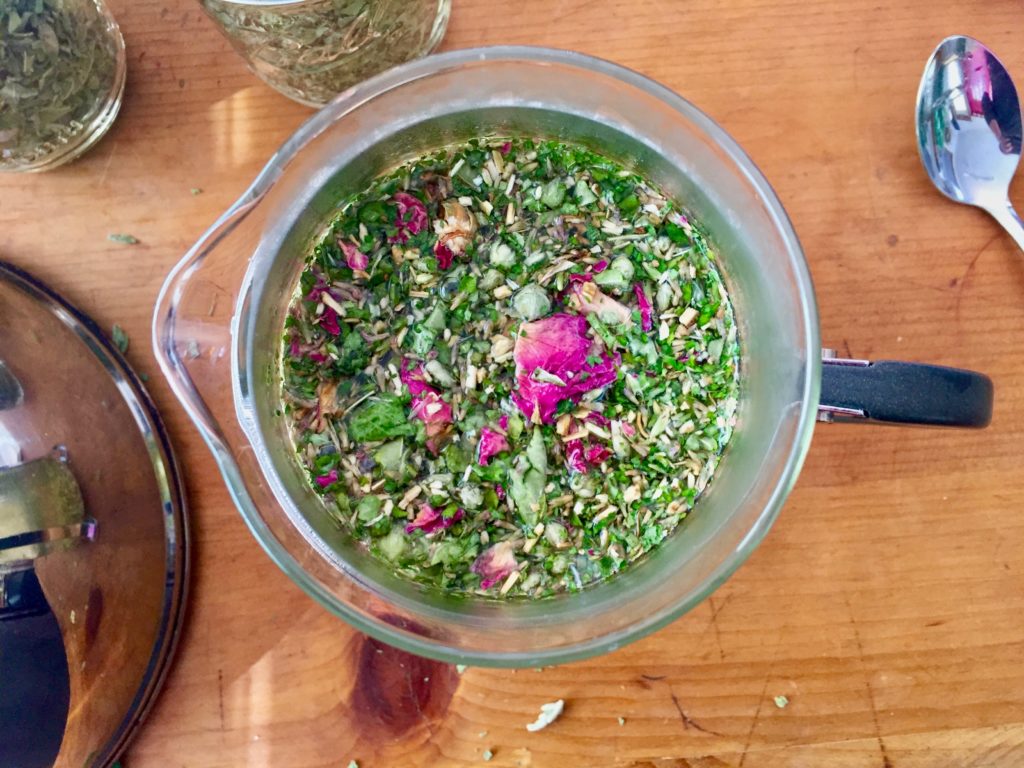
How to Brew a Gut Healing Tea
The exact brew technique can vary by herb, but if your tea has marshmallow or other high-mucilage plant, then a long infusion is best. Start with hot water if there are other herbs in your tea besides just marshmallow. If your tea is all spices, then you might like simply simmering for 20 minutes. For most of my blends, I do the following:
- 1. Add 2 to 4+ heaping tablespoons of herb mix in a quart French Press
- 2. Cover with hot water
- 3. Let steep for 4-8 hours
- 4. Strain, squeezing with the French press
- 5. Drink hot or cold as desired, 1-4 cups per day
- 6. Store extras in the fridge for 1-3 days
How Long Do I have To Take This?
Many gut supportive herbs provide soothing, gas-easing, and digestion stimulating benefits within just thirty minutes of drinking your tea. For a simple acute episodes, just a few days to a month may provide the support you desire. But for longstanding digestive issues, particularly damaged gut lining, you’ll want to drink your gut healing tea daily (or close to that) for a year or longer. Diet and lifestyle changes will often be helpful for your healing process as well.
Tea Alternatives
If you really aren’t a tea person, there are a few other ways you can use these herbs.
- Broth can be made with almost any of these ingredients for a more savory option – using cartilage-rich animal bones may also support gut lining integrity
- Powder, which can be mixed in water, warm milk alternative (such as oat or rice milk), smoothie, broth, oatmeal, gruel, etc.
- Capsules, may not be able to offer the potency of a tea or powder due to sheer size limitations, but they are handy in a pinch
Sample Gut Healing Tea Recipes
Make these recipes in a 32 ounce French Press pot or jar. Use hot water and steep for 4-8 hours unless otherwise specified. (If you’re in a rush, it’s ok to steep for just 30 minutes.) Use these tea recipes as inspiration – feel free to adjust them to your needs, flavor preferences, and the herbs you have on hand.
Simple Marshmallow Overnight Infusion: Steep 1 heaping teaspoon of cut/sifted marshmallow root per cup of cold water. Steep in the fridge overnight. Strain. Drink hot or cold, plain or with other ingredients.
Creamy Marshmallow Oat Milk Tea: Combine 2-3 parts strained marshmallow overnight infusion with 1-2 parts oat milk, 1 teaspoon maple syrup (if tolerated), pinch of nutmeg. This is delicious and soothing served warm. Oat milk tastes great and is more soothing for an irritated gut than higher protein and fat milks (like cow and coconut). I particularly like Oatly oat milk – whether you use the rich and creamy Barista creamer-style, the oil-free “low fat,” or in-between “original.”
Maria’s Basic Gut-Healing Tea: For soothing irritation and promoting healing. 3 heaping tablespoons marshmallow root and/or leaf, 1-2 heaping tablespoons plantain leaf, 4 cinnamon sticks, 10 cloves, 2 star anise pods, sprinkle of rose petals. Many of the other herbs discussed in this article can be added to this blend.
- Need more digestive fire? Add 2-4 cardamom pods and/or ginger to taste
- Constipated? Skip or reduce the cinnamon, which may worsen constipation
- Diarrhea? Double the cinnamon and add a little more rose petals, fresh ginger may be helpful for intestinal bugs
- Gas, pain, and bloating? Add a teaspoon of fennel seeds and perhaps also 2-4 cardamom pods. If marshmallow seems to aggravate gas and bloating, cut back on the dose, swap to marshmallow leaf, or skip entirely.
- Need extra gut-healing support? Add 1 tablespoon gotu kola, pinch of licorice, possibly calendula and more plantain leaf.
- Need it to be more soothing? Use marshmallow root, add a heaping teaspoon of quick oats to the tea, and/or add 1-2 parts oat milk to 3 parts strained tea when serving.
- GI inflammation and pain? Add a tablespoon or two of meadowsweet.
- Stressed or Fatigued? Lemon balm relaxes and uplifts while supporting digestion and the nervous system. Ashwagandha root supports deep energy and nervous system support. Codonopsis is a little more zippy and energizing.
Backyard Gut-Healing Tea: 4 heaping tablespoons marshmallow leaf, 2 heaping tablespoons plantain, 1-2 heaping tablespoons Korean licorice mint (or anise, fennel, or anise hyssop), sprinkle of rose petals. Other great additions include lemon balm, catnip, chamomile, meadowsweet, gotu kola, holy basil.
Chamo-Mint: For gas, pain, colic, sluggish digestion. 1 heaping tablespoon chamomile flowers, 2 heaping tablespoons peppermint, spearmint, or apple mint. Lemon balm or holy basil would also be lovely here.
SIBO-Friendly and for folks on Low FODMAP Diets: 2 heaping tablespoons meadowsweet, 2 heaping tablespoons plantain, 1 heaping tablespoon calendula flowers (optional). Marshmallow leaf is usually well tolerated (2 heaping tablespoons). Licorice, gotu kola, lemon balm, cinnamon, cardamom, pau d’arco are also worth considering.
Learn More
Take my Advanced Gut Repair Online Mini Course! Online, on demand, 3-class mini-course
*bonus access to my recorded Introductory Digestion Class included*
Details and Registration Here
Maria’s Books cover digestion and gut-healing teas. Take an in depth, multifaceted approach in her book Body into Balance(the digestion chapter is the longest chapter in the book!). Learn how to grow and make remedies with gut-healing (and other health-promoting) herbs in her book Grow Your Own Herbal Remedies.
Learn how to grow a Tummy-Soothing Garden on Maria’s full LearningHerbs.com guest blog post here (adapted from Grow Your Own Herbal Remedies)
Click here to listen to Maria’s HerbRally podcast on Heartburn and GERD
Enjoy this interview video with tea demos that I did with KhadiYah Preciado of Her Healthy Home YouTube Channel! Recorded April 28, 2022
LIMITED TIME – SHORT Version of my Gut Healing Class – Moultonborough Public Library 2023 Notes + Slides
Clinical herbalist Maria Noël Groves sees clients and teaches classes at Wintergreen Botanicals Herbal Clinic & Education Center in Allenstown, New Hampshire.
The statements made on this blog have not been evaluated by the FDA and are not intended to diagnose, prescribe, recommend, treat, cure, or offer medical advice. Please see your health care practitioner for help regarding choices and to avoid herb-drug interactions.
The article originally appeared in Herb Quarterly magazine, Summer 2021 issue..

